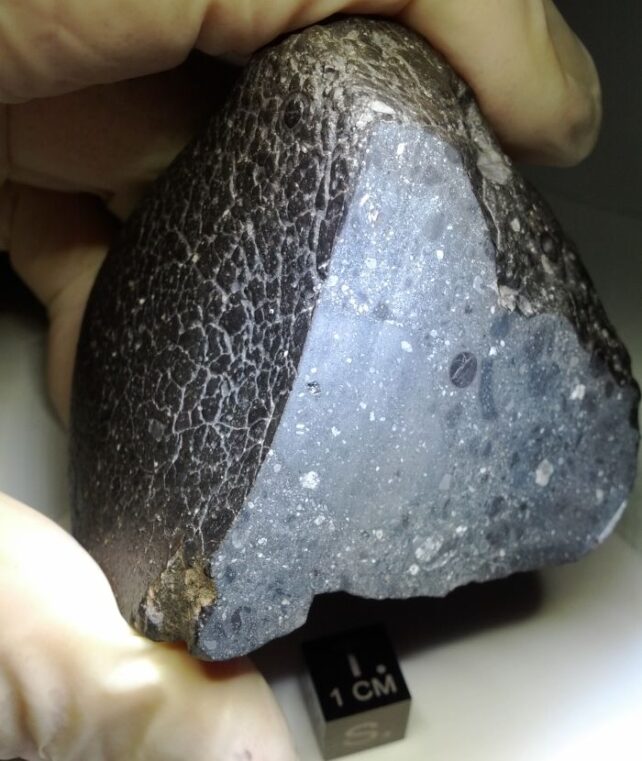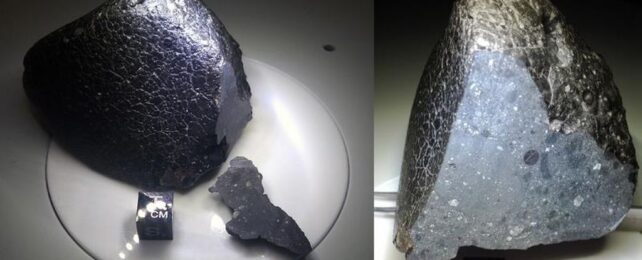A popular and easy method for validating whether or not a chunk of rock is a meteorite, and what kind of meteorite it is, has been inadvertently erasing invaluable information locked inside.
The use of rare-earth magnets such as neodymium erases and overwrites the magnetic record locked inside ferromagnetic minerals in meteorites, scientists from MIT in the US and Paris Cité University in France found. Since many meteorites that fall to Earth have a significant iron content, this means we're losing important data on the way magnetic fields in space have altered these meteorites over billions of years.
"Meteorites provide invaluable records of planetary formation and evolution. Studies of their paleomagnetism have constrained accretion in the protoplanetary disk, the thermal evolution and differentiation of planetesimals, and the history of planetary dynamos.
"Yet, the potential of these magnetic records in advancing the field of planetary science is severely hindered by a widely used technique: application of hand magnets to assist in meteorite classification," write a team led by planetary scientist Foteini Vervelidou of MIT.
"Touching a meteorite with a magnet results in near-instantaneous destruction of its magnetic record."
Exposure to a magnetic field can have an interesting effect on minerals. As a chunk of rock is forming, the crystals within magnetic minerals can align with the magnetic field, and in some cases become magnetized themselves, providing a record of the strength and alignment of the magnetic field that caused it.
Here on Earth, the study of these records is known as paleomagnetism, and scientists use them to understand the history of Earth's magnetic field and how it has evolved and changed over time. The ground beneath our feet is rich in such records, and we've been able to learn a lot about our ever-changing home world.
Other rocky worlds are expected to retain similar records, but our access to them is obviously a lot more restricted. Mars, for example, is of intense interest. Earth's magnetic field is generated by a dynamo: a rotating, convecting, conducting fluid deep inside the planet that converts kinetic energy into magnetic energy.
Mars does not, now, have an active dynamo, and the disappearance of its global magnetic field is a mystery. Ancient rocks from Mars could reveal more about the period in Mars' history in which it did have an active dynamo; and ancient rocks from Mars do occasionally, rarely, make their way here to Earth.

The Black Beauty meteorite, also known as Northwest Africa 7034, recovered from the desert sands of Morocco in 2011, is a famous example. It's one of the oldest Martian meteorites on Earth, and contains fragments dated to up to 4.4 billion years old – when the Solar System, and the planets within it, were just babies.
Scientists thought that it should retain a record of Mars' dynamo at this time, but when they went to check magnetic records in chunks of the rock, they found nothing – not a trace. Whatever magnetic records of Mars remained in NWA 7034 after its journey to Earth had been obliterated by magnets used by meteorite hunters to verify their finds.
This phenomenon has been seen in many meteorites, but no one had undertaken a systemic investigation of how it occurs. So Vervelidou and her colleagues undertook a multi-step analysis, combining numerical modeling, remagnetization of terrestrial basalt using hand magnets, and a study of 9 fragments of the parent meteorite that produced NWA 7034.
First, they calculated the size of a magnetic field around a hand magnet, and the effect that field would have on rocks of various sizes. Next, they tested the results of their calculations on chunks of Earth basalt, measuring the magnetization in the rock before and after exposure to a neodymium magnet.
Many of the chunks were completely demagnetized after being exposed to the hand magnet, and others were consistent with the partial demagnetization observed in chunks of meteorite.
The aforementioned 2014 study of NWA 7034 found the stone had been wiped, but the other fragments of the parent meteorite may still have retained traces of the original magnetic record. So the next step of the research was to test these other fragments. Sadly, Vervelidou and her team found that not a single one of the fragments had any trace of these records. They had all been completely erased.
However, the research did show that magnetic disruption is progressive, and follows a similar demagnetization curve. So scientists studying meteorite magnetization in the future have a guide to how deep the demagnetization may run, allowing them to find samples that retain fossilized magnetic fields, either from planetary processes, or the Solar System itself.
Meanwhile, there are already techniques available that can help identify meteorites without destroying the delicate internal information.
"The use of magnetic susceptibility meters has been shown by many studies to be an accurate and non-destructive meteorite identification and classification technique. They can be used to not only distinguish between meteorites and terrestrial rocks but also to distinguish among different types of meteorites," the researchers write.
"We remain hopeful that more paired stones of NWA 7034 and new Martian meteorite finds will become available in the near future that are free of the effects of magnet remagnetization."
The research has been published in JGR Planets.
